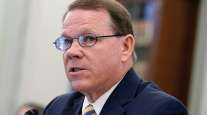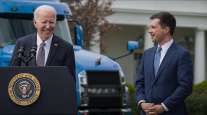Pandemic Offers a Unique Shot at US Infrastructure Reform

[Ensure you have all the info you need in these unprecedented times. Subscribe now.]
Back in early 2017, investing in companies involved in infrastructure projects seemed like a smart idea, given newly elected President Donald Trump’s enthusiasm for building roads, bridges and walls. That it was also a spot of rare bipartisan agreement only bolstered the argument.
Come 2020, that bet has mostly proven to be a dud. The main issue is that while there is consensus that something must be done, the parties still find it near-impossible to agree on solutions. Now that a seemingly out-of-the-blue viral pandemic is threatening to tip the U.S. into a deep recession with skyrocketing unemployment, experts say policymakers now have a unique opportunity to push through a landmark infrastructure initiative.
“When the economy is in recession, additional public infrastructure spending provides a greater short-term boost to economic activity than it does during an expansion,” Pedro Palandrani, an analyst with Global X said in an interview.
Early stimulus plans have focused on speedier measures of relief such as bailouts to companies and handing out cash to Americans, while infrastructure investments typically drive job growth and consumer spending at a much slower pace.
“Infrastructure is about the speed of the recovery,” said Benjamin Salisbury, the director of research at Height Capital Markets, in an interview. “And that conversation is mostly appropriate for after the stabilization of the economy and mitigation efforts.”
While the U.S. economy roared over the past three years — with unemployment at record lows — the political will to reach a common ground and invest in highways, bridges, rails, airports and telecommunication infrastructure had waned, despite campaign promises of trillion-dollar bills from both camps. And as the Trump administration aggressively pursued tax reform and drawn-out trade wars, infrastructure dropped from the headlines.
Glimmer of Hope
Infrastructure returned to the limelight last week after House Speaker Nancy Pelosi said it should be a part of the upcoming stimulus package, being widely referred to as phase four of the relief plan.
Soon, Trump also called for a $2 trillion bill to focus on jobs and rebuilding the U.S. infrastructure. Since then, however, Pelosi has said that such a plan may have to wait until a fifth coronavirus-related relief bill.
In order to address the massive level of unemployment created due to the pandemic — 16.8 million Americans filed for unemployment in the three weeks ended April 4 — policymakers would require extraordinary measures that can create massive job opportunities. Major infrastructure projects seem perfectly suited for just that.
If an infrastructure plan finally appears — be it a part of a broader stimulus plan or a separate bill — the hard lessons learned during this pandemic may dictate the priorities. Hospitals, telecommunication infrastructure and utilities may be some of the winners, experts said, bringing work to construction companies such as Granite Construction, Orion Group, Tutor Perini, Emcor Group, Primoris, Fluor, Quanta Services, Astec Industries and Aecom, and building materials providers like Vulcan Materials, Martin Marietta, Summit Materials, U.S. Concrete and Eagle Materials.
Many Hurdles Remain
Infrastructure projects in the U.S. have such a habit of getting stuck, that nothing short of a crisis can get the ball rolling, some say.
“It really would take something of a global pandemic to pull one together,” Veda Partners’ Henrietta Treyz said in an interview. The analyst has recently raised the possibility of a $2 trillion infrastructure package being approved this year to 30% from zero, reflecting the window of possibility that the COVID-19 outbreak has created for such a plan.
The current unprecedented conditions may help bring about an agreement on how to pay for that hefty price tag, as well as an understanding among both parties on which projects to fund.
One major “barrier to an infrastructure bill is how to pay for it,” Height’s Salisbury said. “That piece also becomes easier when people are less conscious about the debt or deficit.”
Want more news? Listen to today's daily briefing:




